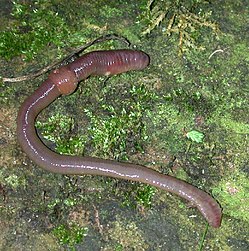| Lumbricus | |
|---|---|
 | |
| Lumbricus terrestris , the common European earthworm | |
| Scientific classification | |
| Domain: | Eukaryota |
| Kingdom: | Animalia |
| Phylum: | Annelida |
| Clade: | Pleistoannelida |
| Clade: | Sedentaria |
| Class: | Clitellata |
| Order: | Opisthopora |
| Family: | Lumbricidae |
| Genus: | Lumbricus Linnaeus, 1758 |
| Type species | |
| Lumbricus terrestris [1] Linnaeus, 1758 | |
| Species | |
The genus Lumbricus contains some of the most commonly seen earthworms in Europe among its nearly 700 valid species. [2]
Characteristics of some commonly encountered species are:
- Lumbricus rubellus is usually reddish brown or reddish violet, iridescent dorsally, and pale yellow ventrally. They are usually about 25–105 mm in length, and have around 95-120 segments.
- Lumbricus castaneus varies from chesnut to violet brown; brown or yellow ventrally, and has an orange clitellum. They are usually about 30–70 mm long, and have around 82–100 segments.
- Lumbricus terrestris has several common names, including common earthworm, nightcrawler, and dew worm. It is strongly pigmented, brown-red dorsally, and yellowish ventrally. Setae are widely paired at both ends of the body. It is about 90–300 mm long, and has around 110–160 segments.
- Lumbricus festivus is not found in large numbers. It is red-brown, lighter ventrally, iridescent dorsally. The body length varies from 48 to 108 mm, with about 100–143 segments.
- Lumbricus badensis , the giant earthworm, also belongs to this genus. Its range is restricted to the Black Forest area of southwestern Germany. It is very large and grows up to 600mm.